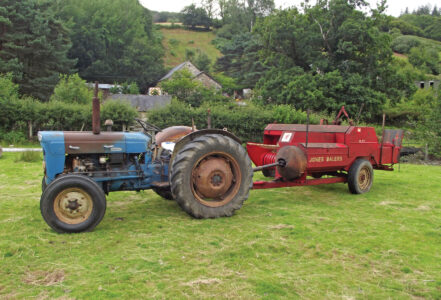One of our favorite classic tractors here in the U.K. is the Fordson Dexta, which Ford introduced in the late 1950s. Ford hoped that the new exciting design of the Dexta would help the company gain an upper hand in a market that was largely dominated by Ferguson (and later Massey Ferguson) tractors.
Fordson (Ford) had a factory in Dagenham, England, and by the late 1950s, the company had already gained an excellent reputation with their earlier tractors, the Fordson Model N, the E27N, and the Fordson Major, all of which were extremely popular with British farmers.
There were three versions of the Fordson Dexta. The first model in the range, built in in 1957, featured a 32hp 3-cylinder 2.4-liter engine, which was based on a Perkins P3 engine, made to Ford’s requirements. A petrol (gasoline) version was also available, but this was never as popular as the diesel version, which sold in large numbers.
At the Royal Smithfield show in 1961, Fordson launched their second version of the Dexta, the “Super Dexta,” which had a 40hp output. The increased power proved to be a good selling point.
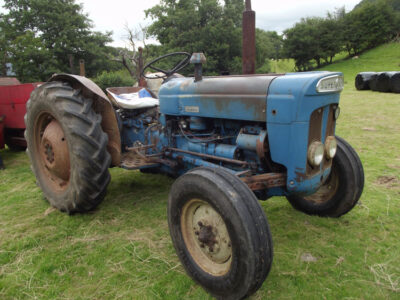
Finally, in order to go out on a high in 1963, Fordson produced their final tractor in the Dexta range: the “New Performance Super Dexta.” This top-of-the-range “New Performance” Dexta featured a 44.5hp engine and a modern looking blue and grey color scheme. In 1964, the production of Dexta tractors ended, as did “Fordson,” as from this point on the Fordson name was dropped, and all of Ford’s tractors were simply badged as “Ford.”
The entire Dexta range was hugely successful, and it’s thought that in excess of 200,000 of these tractors were sold, and many of these are still in use today, with some being used on smallholdings, and many others can be seen being driven on road runs or at ploughing events and shows.
Local Provenance
North Wales-based agricultural mechanic Fig Roberts has always liked the simplicity of older tractors. He was already the proud owner of a Fordson Model N, a similar tractor to the one his grandfather used to drive many moons ago. But as well as having a soft spot for the tractors of his grandfather’s era, Fig also admired classic Fordson Dexta tractors, because whilst the Dexta is compact and easy to maintain, it is still capable of a good day’s work, and can be used for many of the tasks required on a small farm.
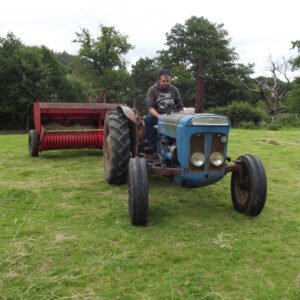
So whilst enjoying taking his Fordson Model N to shows, Fig began idly keeping an eye out for a good original-looking Dexta to add to his collection. Fig was in no hurry though, he was holding out for the right tractor, because he didn’t want just any old Dexta, rather he was hoping to find a top of the range “New Performance” Dexta. He was also hoping to find a “local tractor,” and by that, I mean a tractor that had been originally sold through a dealership in the part of North Wales that Fig lived, and which had spent its working life in the area.
It’s fair to say that some collectors just want a rarity and they don’t care where it comes from, but generally provenance is important to British collectors. Knowing the place where your tractor was first sold, and where it worked “back in the day” is super desirable. Most collectors like to know the company history of their tractors, but many also like to know the “personal history” of their tractors. In the past, every road-registered tractor had a license plate that featured letters relating to its registration area, so tractors with local license plates are always desirable.

In 2019, Fig hit the jackpot when he discovered a 1964 New Performance Super Dexta for sale. This tractor was sold through Jones Bros, a Ford dealership in Fig’s local market town of Llanrwst. What’s more, the tractor had remained in the Conwy Valley ever since and had worked on farms that were known to Fig.
While Fig likes to take his collectible tractors to local shows, he also likes to use them for work where possible. There is a limit to the kinds of work Fig’s much loved Fordson Model N could do. With the arrival of the Fordson Dexta, Fig had high hopes for a good hay harvest that would provide him with the opportunity to put the tractor through its paces.
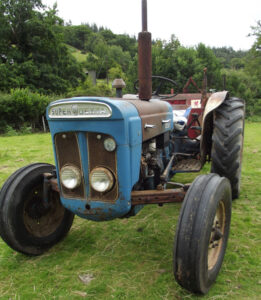
The wetter summers that we now seem to encounter in North Wales have made it increasingly difficult for those of us who want to make our own hay. Without silage and haylage to turn to for our winter fodder, we would be in trouble, because it seems to be nigh on impossible to find a forecast that promises four or five hot days at a time. Here the forecasts can change so rapidly that farmers often cut their hay and have to keep their fingers crossed that the sunshine that has been forecast actually materializes as promised. Sometimes a farmer will cut the crop with hay in mind, but then the forecast will change and the plan has to change with it, so many a crop that was destined for hay has to be quickly round baled and wrapped as haylage before the rain comes.

But, when it all goes well, there is something wonderful about making hay. There’s the sight of those golden rows of ready to bale hay, and then afterwards the sweet smell of freshly baled hay safely stacked in the barn. Carrying the hay in from the fields requires a camaraderie that is rarely felt in modern farming, and which makes haymaking feel much more like a “traditional harvest” than silage or haylage making ever does.
Small bale haymaking has become a rarer sight in our fields, not only because of our unpredictable weather, but also because small bale haymaking is physically demanding, time consuming, and labor intensive. Not all of us have a readily available, fit workforce who are willing to work hard lifting and stacking bales.
This time it was all looking promising for a good hay crop, and Fig was anxious to get his machines out in the fields and working. What made this harvest all the more exciting was that Fig not only had the Fordson Dexta to use, he also had a “new” baler to try out, for he had managed to purchase a period baler, and this was not just any old baler, but a Welsh-built baler.
The Welsh Baler
Here in the U.K., there are plenty of English-built collectible implements to be had, but there are far fewer Welsh-built machines. The only Welsh company that produced balers was Jones Balers, who were based in Rhosesmor, North Wales. It should come as no surprise that Jones Balers machines are quite sought after by Welsh enthusiasts, and Fig was no exception in wanting one. “I’ve always liked the idea of having my own Jones baler” he said, “it’s nice to have something that was made in Wales.”

As a new baler, Fig’s Jones Mark 10T was sold through the local dealership, Burgess, in Llanrwst, in the Conwy Valley. Frederick H. Burgess initially founded the Burgess Co. in 1900, and it went on to become one of the U.K.’s largest distributors of tractors and agricultural machinery. Both Fig and myself have met several former Burgess employees who have gone on in to become vintage and classic tractor enthusiasts, and who now collect the type of tractors that they once sold and serviced back in their youth.
Like many great institutions, Jones Balers and Burgess are now sadly both defunct, so owning and preserving items made and sold by these companies is something quite special. It is also quite remarkable that Fig managed to find not only a tractor, but also a baler that were both sold through the little town of Llanrwst. While we in Wales call this a town, it is such a small place of just over 3,000 inhabitants, and many people would class it is a village rather than a town.
The Jones Brothers
At one time, I recall being a little concerned that old balers could become scarce. It seemed that most farmers had given up using old-style balers, and while there were plenty of people preserving old tractors, it didn’t seem like anyone cared much about old balers. I imagined that many of these balers were either left in the corners of fields to rot, or had been scrapped. Then a few years ago, I noticed that there were social media groups celebrating “collectible balers,” and I knew then that at least some of our nation’s old balers would be safe from the scrap-man.

Jones balers are popular with collectors throughout the U.K., but the story of the Jones baler company evokes a sense of patriotic national pride in the hearts of many Welsh people. The Jones Balers company history reads like a rags-to-riches story. It begins with two Welsh brothers, David and Glynne Jones, the sons of tenant farmers who had sadly lost their land. With no farm of their own the brothers became agricultural contractors, starting with hard manual work like ditch digging. The pair soon became successful small-time agricultural contractors. Having to mend their own machinery meant that the brothers became self-taught engineers, and they began building their own stationary balers.
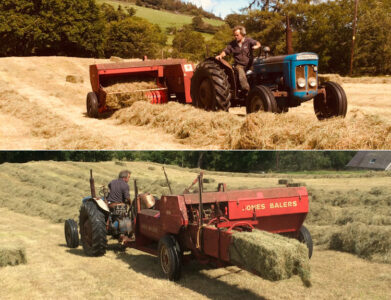
David and Glynne would design and build some highly innovative balers, including a self-propelled baler. They also came up with some world beating designs with one of their most famous being their highly successful Jones Super Star baler. So the Jones story is one that shows how from very small, humble beginnings, two hard working young men managed to build up a successful company. Jones was eventually sold to Allis Chalmers, but the Jones name lives on in the hearts of many Welsh people, and Jones balers have become very sought after amongst collectors.
Modern Haymaking
Going back to haymaking, one can run a baler to see if it works to a certain extent, but there’s only one way to properly try out a baler and that is to use it to bale a field of hay. The proof of the pudding is in the eating so to speak. In anticipation, Fig had serviced both the tractor and the baler, and they were ready to run. But just as the hay was drying nicely the fine weather started looking like it could break, and Fig’s father, Wil, was wondering whether it might be wise to just use the round baler and make haylage to get the crop harvested and wrapped, rather than risk it.

Fig, however, was desperate to try out the baler, and was hopeful that the weather would hold, so he persuaded Wil to hold fire, thinking at the same time that he would never hear the end of it if the crop got rained on…. Such are the joys of haymaking in an unpredictable and fast changing climate. There is so often a “Do I or don’t I” dilemma to be had when it comes to haymaking. Now, when detailed weather forecasts for your region can be viewed on the internet, it is all too easy to be caught up in a situation where you can’t stop checking the forecast. Given it changes every few hours, especially near the sea and the mountains, weather checking can become pretty obsessive, and hay making can be a tense time.
In the end, the weather held, and Fig was able to get started on baling the well dried hay. Things looked a bit shaky at the start when the baler’s knotter failed to tie the first few bales, but after a couple of adjustments, it baled perfectly and didn’t miss another bale all throughout the afternoon. Part way through the baling, Fig decided to give his dad Wil a trip down memory lane by letting him take the wheel for the second half of the baling. Both the tractor and baler were built while Wil was still a young man, and these were the sort of machines that he had used during his early days of farming, so it was a real “blast from the past” for Wil to be able to use this classic duo to do some old style haymaking with.
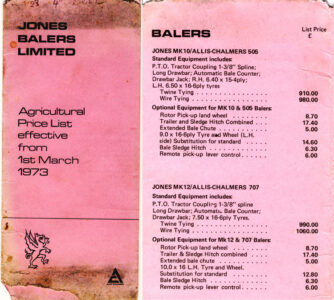
As for Fig, he was thrilled that the tractor and the baler had worked so well.
Haymaking is without a doubt labor intensive and annoyingly weather dependent, but there’s nothing like the satisfaction of seeing a well-stocked hay-barn full of sweet smelling hay at the end of the day. If you can incorporate your favorite old machines into the haymaking process then all the better, because after all, the best way to preserve a thing is to use it.
Many thanks to Gwynfor Williams, author of the book The Jones Baler Story, for his information on the Jones Mk 10 baler.
Josephine Roberts lives on an old-fashioned smallholding in Snowdonia, North Wales, and has a passion for all things vintage. Email her at josiewales2021@aol.com

